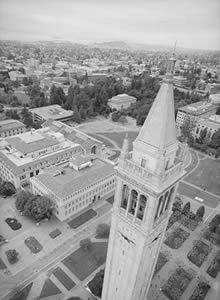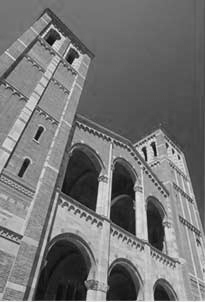|
INSPIRATIONAL PEER TOWNS |
||||
|
NEWS By TONY WU The Terrapin Times Staff Writer
There are some activities (for example Parliamentary Debate) on this fair campus that afford students the opportunity to travel every weekend to visit a new college and college town, which invariably conjure up ponderings of what might have been. For the rest of us however, there is little opportunity to compare what is offered in College Park to the amenities of the college towns of our peer schools.
University of California - Berkeley
So, The Terrapin Times decided to take a look at how the living and retail environment of our university stacks up to five institutions that have “historically set the standards of eminence,” according to the University of Maryland’s mission statement, and which are designed as our “inspirational peer schools.” Neither the University of Maryland nor a single one of the five schools – UCLA, UC Berkeley, UNC – Chapel Hill, University of Michigan – Ann Arbor, and the University of Illinois – Urbana-Champaign, have made it onto the top 40 college towns, according to Outside Magazine, which ranks towns based on the outdoors environment as well as the “ivory tower.” However, Collegia, a Massachusetts consulting company, ranks Chapel Hill, Ann Arbor, and Champaign-Urbana all as Tier 1 college towns, but not, unsurprisingly, College Park. The company picks the most student-friendly metropolitan areas in three population categories (less than 1 million, more than 2.6 million, and in between). Ann Arbor, Michigan, a college town on the Huron river, is ranked number 10 on the Best Places to Live and Work in America, compiled by BestJobsUsa.com in 2002. It is also ranked No. 2 on the “Most Wired Cities” list, compiled by Media Audit the same year. Despite being a small town, it has about 5 historic sites and museums, including the Gerald R. Ford Presidential Library.
Overall, Ann Arbor offers fine eating establishments (A search on Switchboard Yellow pages turns up about 430 restaurants), many bookstores, and a lively arts scene. As you may have guessed, it has a strong economy with an impressive unemployment rate of only 1.6% in 2000 and plenty of technology companies, defying the rust belt image of other Michigan locales. The combined college enrollment is about 41,000 students (coming from about three universities) in a total city population of little more than 100,000. In 2000, about 37 crimes per 1,000 persons were reported in Washtenaw County, Michigan, where Ann Arbor is located, according to data provided to the University of Michigan by the FBI. |
The University of Illinois - Urbana-Champaign Urbana-Champaign, home of the University of Illinois, is also quite impressive, a medium-sized city with a strong arts scene, plenty of restaurants (the Switchboard search turns up 238) and book stores, as well as well-supported public libraries. The unemployment rate in 2000 was also well below the national average at 2.4%. Of the two cities, Champaign, named for the area’s flat landscape, is the larger one with a population of about 67,000 out of a total of around 100,000 (about 40,000 of whom are students) and hosting three 4-year institutions. Urbana, for its part, hosts a natural history museum, an art museum, and a large pavilion, for a population of just 36,000. Crime data for Urbana-Champaign was unavailable. Only slightly less student-friendly is Berkeley, near San Francisco Bay and home of the distinctively liberal University of California campus, which in many ways was shaped by the decades-long history of the college’s political activism. The city itself hosts plenty of bookstores and libraries, but has a slightly lower percentage of students than Ann Arbor or Urbana, with only 30,000 students for roughly the same population as the other two cities. The median age is also higher than the average for college towns, standing at around 32, just three years below the national average.
University of California - Los Angeles A Switchboard search found about 473 restaurants in Berkeley. The crime rate in 2000 was slightly higher than Ann Arbor at 47 incidents per 1,000 persons in Alameda county, and the unemployment rate stood at 3 percent, just one percent below the national average that year. Now we move on to a smaller college town, Chapel Hill, named for the New Hope Chapel of the Church of England which was built on the hill. For many students, Chapel Hill is the ideal college town, and the university it hosts, UNC Chapel Hill, is the country’s oldest public university, founded in 1795.
|
|
As part of North Carolina’s research triangle, the area’s information technology industry – and reputation -- boomed in the 1990’s. UNC Chapel Hill has also benefited from its proximity to Duke University and North Carolina State University. Fully half the population, of approximately 50,000, is composed of students, and the median age is ten years lower than the national average. The unemployment rate in 2000 stood at a stunning 1.3%, less than a third of the national average. The town may be small, but it has five museums, 190 restaurants, two historic sites, a botanical garden, and a planetarium. Raleigh-Durham-Chapel Hill was ranked the best place to live in the South by Money Magazine in 2000 and the No. 9 best city for entrepreneurs by Entrepreneur magazine the following year. The crime rate stood at about 46 incidents per 1,000 persons in 2000. Finally, we move to a college environment that is far less inspiring than that of the other peer schools, the city of Los Angeles, with a population of 3.6 million. The city has a whole hosts 35 colleges, 40 parks, 49 museums, a major military base, and a stunning 5,300 restaurants, but only 12 historic sites. The crime rate in Los Angeles county was actually lower than Berkeley and Chapel Hill, at only 40 per 1,000 persons in the year 2000. In the second quarter of 2003, the unemployment rate stood at 6.6%, only marginally higher than the national average, according to the Bureau of Labor Statistics. Otherwise, such a large city is probably incomparable to other college ‘towns’. How does College Park stack up to our “peer schools”? The Switchboard Yellow pages search turned up only 76 restaurants, about one-fifth of those in Ann Arbor or Chapel Hill for a town serving almost the same number of students. The PG county crime rate also stood at 64 per 1,000 persons in 2000, blowing all of our peer schools, even UCLA, out of the water. The only bright spot is the unemployment rate, which stood about 1 ½ percentage points below the national average at just 4.7 percent in the second quarter of 2003. College Park also has a dearth of historic sites and museums, although within a 20-mile radius, including D.C., there are plenty. When
comparing schools for undergraduate and graduate admissions, applicants
often take a look at the surrounding area and what it has to offer. The
brightest spot for the University of Maryland continues to be the close
proximity students have to our nation’s capital. However, the city of
College Park, doesn’t come close to stacking up next to the cities of our
inspirational peers.
The University of North Carolina - Chapel Hill An example of a real college town? |
|



